For years, the mechanics of reading and math have been called the “hard skills”. The “hard skills” have been the emphasis of education for so many years. Because they can be taught, memorized, tested, and retested until mastery. Teaching “soft skills” have seemingly taken a backseat. That is until recently! Each year we welcome students into our classrooms that have intensive trauma, mental health issues, and emotional disorders. The “soft skills” of social, emotional, and behavioral control are beginning to require not only some of the teacher’s focus, but also some consideration from the policy makers.
Working on those developmentally appropriate “soft skills” is a great reason to have math centers up and running. If math stations are new for you, a shapes unit may be the easiest topic to introduce these skills to your class. Here are three stations that work amazingly well.
Station 1: Play Doh
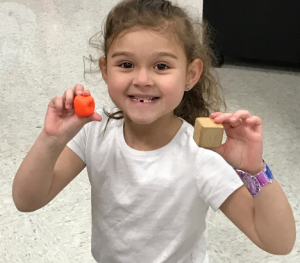 For some, Play Doh makes you smile. You love the texture and all the uses for it. For others, and I know you are out there, instantly picture orange blobs stuck in carpet or blue underneath fingernails. No matter which side of the Play Doh debate you fall on, you can’t deny that it’s a great tool for multi-sensory learning.
For some, Play Doh makes you smile. You love the texture and all the uses for it. For others, and I know you are out there, instantly picture orange blobs stuck in carpet or blue underneath fingernails. No matter which side of the Play Doh debate you fall on, you can’t deny that it’s a great tool for multi-sensory learning.
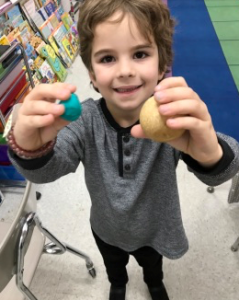
The first station that I put out is one of my classroom’s favorite. When I get Play Doh out, my kids smile from ear to ear. I put out my 3D wooden shape blocks (cube, sphere, cylinder, cube) and one container of Play Doh for each child in the station. I try to make sure that all the containers are the same color because this takes care of lots of issues before they even come up. Each child gets a wooden shape and a container of Play Doh, and they must figure out how to make their “blob” of Play Doh look like their shape with the right number of faces, edges, and vertices. They use those math terms when sharing their shapes with others. They then switch shapes with the others in their group until it is time to rotate to the next station.
The Rules
When I can’t have all the same color, I make sure that when I am giving the directions for that station, I make the statement, “We don’t mix the Play Doh.” and then I have them repeat it. I then say, “It doesn’t matter what color I have!” and my class repeats that sentence as well. The other rule worth mentioning here is that the Play Doh and the wooden shapes should never touch. Each class has those brilliant children that quickly realize that wrapping your wooden shapes in your Play Doh meets the objective without much work. I love the genius behind those thoughts, but that defeats the point of this station.
Station 2: Builders
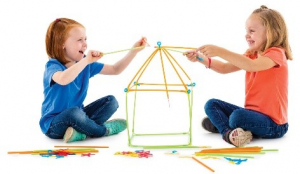
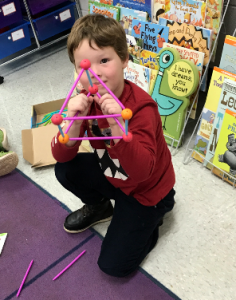 There are lots of kits out in the world where students make 3D shapes. If you don’t have a kit, make your own kit by using toothpicks and marshmallows or Play Doh. There is a multitude of different kits out there as well like the SmartMax Building Sets or the STEAM School Kit that even comes with an activity guide! The only prep for this station is to create 3D building cards for the children to mimic at this station. This can easily be done by building different shape and taking a picture. Need to differentiate it for your high-flyers? Have them make two 3D shapes and then combine the two shapes to make one new shape! For example, triangular prism on top of a cube looks like a house. There are cards for that skill too!
There are lots of kits out in the world where students make 3D shapes. If you don’t have a kit, make your own kit by using toothpicks and marshmallows or Play Doh. There is a multitude of different kits out there as well like the SmartMax Building Sets or the STEAM School Kit that even comes with an activity guide! The only prep for this station is to create 3D building cards for the children to mimic at this station. This can easily be done by building different shape and taking a picture. Need to differentiate it for your high-flyers? Have them make two 3D shapes and then combine the two shapes to make one new shape! For example, triangular prism on top of a cube looks like a house. There are cards for that skill too!
This station is a pre-packed kit, but honestly, who has time to make all guided math and reading stations! This kit is so well done that it meets all the standards I need my children exposed to in this unit!
Station 3: Shape Seekers
I am SO blessed to work on a team of teachers who make me a better teacher. One of my teammates and friend, Jessica Skeens, found and made these shape seekers. She printed them off on colored paper, laminated them, and then cut them out leaving the lamination in the middle of the shape for the students to look through.
 I brought the kids to my table and gave them the instructions that they had to find two of each shape in the classroom. This was a great time to review the difference between 2D shapes and 3D shapes. I review it because their shape seekers are 2D so where they have been building 3D shapes, these help us spiral back to the 2D shapes that we must know by the end of kindergarten (circle, square, rectangle, hexagon, triangle). Each child needs to bring me back the name of two objects that fit each shape. Once an object has been said, it can’t be repeated by another member of the group. They must communicate about what they are finding around the room so that all members of the group get their objects.
I brought the kids to my table and gave them the instructions that they had to find two of each shape in the classroom. This was a great time to review the difference between 2D shapes and 3D shapes. I review it because their shape seekers are 2D so where they have been building 3D shapes, these help us spiral back to the 2D shapes that we must know by the end of kindergarten (circle, square, rectangle, hexagon, triangle). Each child needs to bring me back the name of two objects that fit each shape. Once an object has been said, it can’t be repeated by another member of the group. They must communicate about what they are finding around the room so that all members of the group get their objects.
I love all these stations because they get to communicate with their classmates by problem-solving and giving complements and encouragement. I firmly believe it’s because they get a chance to practice and build their “soft skills” while also working on those “hard skills” that the math standards are built upon.

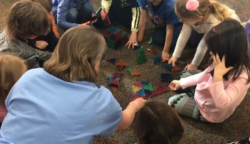
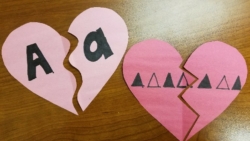
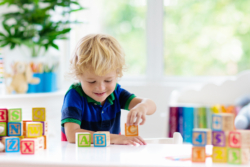
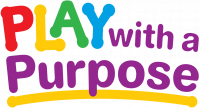

Leave A Comment